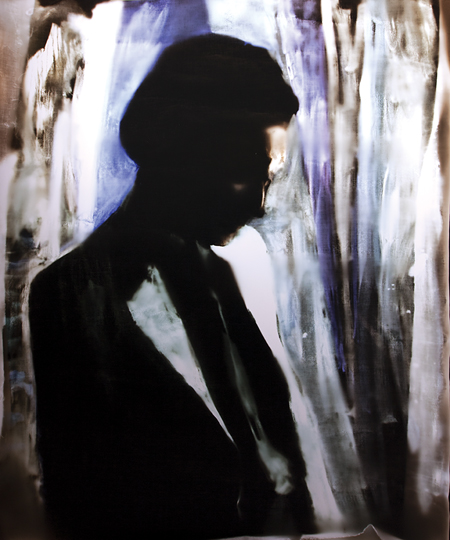Matt Saunders

Matt Saunders continues to expand and merge the technical and representational repertoires of photography, drawing and painting in a new body of work that remains anchored deep in cinematic space and time, and that also gestures toward a more luminous poetic realm. Saunders borrowed the title of this exhibition ‘A Step Away from Them’ from a 1956 poem by Frank O’Hara that captures the author’s lunchtime stroll through a bright hot New York City – its ‘hum coloured cabs’, and its ‘cats playing in sawdust’. The sunlit imagery of the poem contrasted sharply with the damp, dusky palette of burgundy, violet and moss green that saturated the concise presentation of Saunders’s chromogenic prints on the ground floor, providing a little shade, or visual relief, to eyes parched by the pristine white of the gallery walls.
Speculating about the relationship between O’Hara’s poem and Saunders’s chromogenic prints somehow convinced this viewer of the peculiar magic conjured by photography and cinema’s manipulation of light and shadow. Saunders’s prints come about through an intricate method: working from found or sourced photographs or film footage, the artist draws and paints in order to create by hand what is essentially a negative: for example, by applying ink to Mylar. He then exposes this negative image on photographic paper or canvas to light. While he employs certain technical equipment available in a photographic darkroom, such as an enlarger, and while the images themselves result from a time-tested chemical reaction, these photographs are made without a camera held to the eye, without a viewfinder or lens, without the click of a shutter. Photographic terms and processes are very much in play, but accuracy and fidelity to an external image are undermined in favour of an outcome that sees figures emerging as if captured in a murky limbo between photography and painting. External referents are, however, visible in Needle Park #4, version 1 (2013) or in the series ‘Borneo (Rose Hobart)’ (2014). Like most of Saunders’s works, both these projects are based on film stills, the latter taken from Joseph Cornell’s experimental work Rose Hobart (1936), a re-edited compilation of all the footage of the actress in East of Borneo (1931). The handmade, tactile quality of these photographic ‘copies’ is exquisitely rendered in the fluid, almost transparent, painterly strokes Saunders uses to construct the images. His touch brings the photographic and painterly – rivals since photography’s inception in the late 19th century – squarely into dialogue.
There is a composed stillness in the portraits and landscapes, though a raw energy seems to simmer beneath their surfaces. This energy is fully unleashed in Saunders’s multi-channel video installation Reverdy/King Hu (2014), which occupied the basement galleries. Whereas our access to the images on the ground floor was decidedly frontal, the asymmetrical, spatially disorienting positioning of the screens in Reverdy/King Hu situated the viewer in a quasi-immersive experience that instantly engaged both the body and the eye. A rush of hand-drawn and painted animated pictures – a figure facing away or a person riding a bicycle – competes for our attention with lush and pellucid panels littered with brushstrokes, splurts and blobs of magenta, azure blue and marigold. Inspired again by a poet, this time Pierre Reverdy (whom O’Hara references at the end of ‘A Step Away from Them’), and by Chinese martial arts film director King Hu, beams of light bounce and reflect, rainbow hues refract in the dark in what Reverdy might call a ‘Spectacle for the Eyes’ (1915). There was such a radical shift in atmosphere from one gallery to the next: it was as though the boisterous, fragmentary aesthetic of the video installation lead us further than a step away from the more collected images upstairs and into a territory of visual commotion – where, one hopes, Saunders will linger.

















